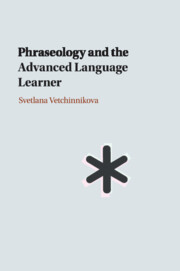Book contents
- Phraseology and the Advanced Language Learner
- Phraseology and the Advanced Language Learner
- Copyright page
- Contents
- Figures
- Tables
- Acknowledgements
- Abbreviations
- Chapter 1 Introduction
- Chapter 2 From a Unit of Meaning to a Meaning-Shift Unit
- Chapter 3 L2 Use and Processing of Multi-Word Units
- Chapter 4 Triangulating Usage, Exposure and Processing
- Chapter 5 Meaning-Shift Units in L2 Learning and Use: Usage vs. Exposure
- Chapter 6 Meaning-Shift Units in L2 Processing: Usage vs. Word Association Responses
- Chapter 7 Towards the Bigger Picture
- Book part
- References
- Index
Chapter 2 - From a Unit of Meaning to a Meaning-Shift Unit
Published online by Cambridge University Press: 18 November 2019
- Phraseology and the Advanced Language Learner
- Phraseology and the Advanced Language Learner
- Copyright page
- Contents
- Figures
- Tables
- Acknowledgements
- Abbreviations
- Chapter 1 Introduction
- Chapter 2 From a Unit of Meaning to a Meaning-Shift Unit
- Chapter 3 L2 Use and Processing of Multi-Word Units
- Chapter 4 Triangulating Usage, Exposure and Processing
- Chapter 5 Meaning-Shift Units in L2 Learning and Use: Usage vs. Exposure
- Chapter 6 Meaning-Shift Units in L2 Processing: Usage vs. Word Association Responses
- Chapter 7 Towards the Bigger Picture
- Book part
- References
- Index
Summary
Chapter 2 provides an in-depth discussion of Sinclair’s conceptualization of lexis and meaning and its major concepts. It starts from the model of a unit of meaning and explains how it is capable of incorporating both syntagmatic and paradigmatic axes of meaning by including optional variable components of collocation, colligation and semantic preference. The chapter continues by offering a theoretical solution of removing the borderline between single- and multi-word units. Further it points out the difference between Firth’s and Sinclair’s conceptions of collocation and defines the relationships between the idiom principle, co-selection, syntagmatic association, core meaning, delexicalization and meaning-shift. A large part of the chapter is devoted to examining the controversy around the concept of semantic prosody. The chapter concludes by discussing Sinclair’s theory of meaning and his idea of the ultimate dictionary. The conceptualization presented in the chapter forms the theoretical backbone of the book.
Keywords
- Type
- Chapter
- Information
- Phraseology and the Advanced Language Learner , pp. 9 - 37Publisher: Cambridge University PressPrint publication year: 2019

